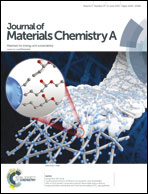Thermoelectric properties of Ge doped n-type TixZr1−xNiSn0.975Ge0.025 half-Heusler alloys
Abstract
Several compositions of the n-type, TixZr1−xNiSn0.975Ge0.025 (x = 0, 0.1, 0.15 and 0.25), half-Heusler (HH) alloys were synthesized by reacting elemental powders at high temperature using induction melting. The resulting ingots were annealed at 900 °C for 2 weeks and mechanically alloyed to achieve fine grain size. X-ray powder diffraction suggested the formation of products with HH structure. However, electron microscopy studies revealed phase separation into Ti-rich and Zr-rich domains for the ingot with x = 0.25. The effect of band gap engineering through isoelectronic substitution of Sn by Ge and mass fluctuation arising from the intermixing of Ti and Zr in the HH structure on the electronic and thermal transport in the temperature range from 300 K to 775 K was investigated. A large reduction in the lattice thermal conductivity (4.9 W K−1 m−1 to 2.7 W K−1 m−1 at 300 K) was observed with increasing Ti concentration. Surprisingly, the thermopower and electrical conductivity for the sample with x = 0.25 simultaneously increase with rising temperature from −120 μV K−1 and 510 S cm−1 at 300 K to −160 μV K−1 and 840 S cm−1 at 775 K. The combination of large reduction in lattice thermal conductivity via mass fluctuation at the Ti/Zr site with optimization of the thermopower and electrical conductivity through Ge substitution at the Sn site significantly improved the figure of merit from 0.05 to 0.48 at 775 K for the sample with x = 0.25.


 Please wait while we load your content...
Please wait while we load your content...